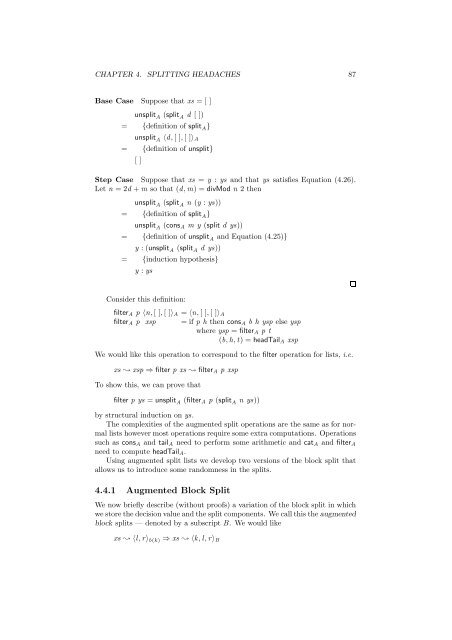Obfuscation of Abstract Data-Types - Rowan
Obfuscation of Abstract Data-Types - Rowan
Obfuscation of Abstract Data-Types - Rowan
You also want an ePaper? Increase the reach of your titles
YUMPU automatically turns print PDFs into web optimized ePapers that Google loves.
CHAPTER 4. SPLITTING HEADACHES 87<br />
Base Case Suppose that xs = [ ]<br />
unsplit A (split A d [ ])<br />
= {definition <strong>of</strong> split A }<br />
unsplit A 〈d, [ ], [ ]〉 A<br />
= {definition <strong>of</strong> unsplit}<br />
[ ]<br />
Step Case Suppose that xs = y : ys and that ys satisfies Equation (4.26).<br />
Let n = 2d + m so that (d,m) = divMod n 2 then<br />
unsplit A (split A n (y : ys))<br />
= {definition <strong>of</strong> split A }<br />
unsplit A (cons A m y (split d ys))<br />
= {definition <strong>of</strong> unsplit A and Equation (4.25)}<br />
y : (unsplit A (split A d ys))<br />
= {induction hypothesis}<br />
y : ys<br />
Consider this definition:<br />
filter A p 〈n, [ ], [ ]〉 A = 〈n, [ ], [ ]〉 A<br />
filter A p xsp = if p h then cons A b h ysp else ysp<br />
where ysp = filter A p t<br />
(b,h,t) = headTail A xsp<br />
We would like this operation to correspond to the filter operation for lists, i.e.<br />
xs ❀ xsp ⇒ filter p xs ❀ filter A p xsp<br />
To show this, we can prove that<br />
filter p ys = unsplit A (filter A p (split A n ys))<br />
by structural induction on ys.<br />
The complexities <strong>of</strong> the augmented split operations are the same as for normal<br />
lists however most operations require some extra computations. Operations<br />
such as cons A and tail A need to perform some arithmetic and cat A and filter A<br />
need to compute headTail A .<br />
Using augmented split lists we develop two versions <strong>of</strong> the block split that<br />
allows us to introduce some randomness in the splits.<br />
4.4.1 Augmented Block Split<br />
We now briefly describe (without pro<strong>of</strong>s) a variation <strong>of</strong> the block split in which<br />
we store the decision value and the split components. We call this the augmented<br />
block splits — denoted by a subscript B. We would like<br />
xs ❀ 〈l,r〉 b(k) ⇒ xs ❀ 〈k,l,r〉 B
















